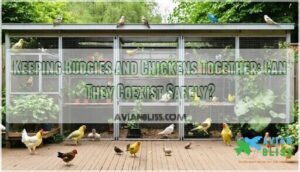This site is supported by our readers. We may earn a commission, at no cost to you, if you purchase through links.

Size matters – provide ample space with separate feeding stations to prevent competition.
Chickens are substantially larger and can intimidate budgies, so watch for signs of stress like hiding or reduced appetite.
Create visual barriers and multiple perches to give your feathered friends escape routes.
Some budgies adapt quickly while others need weeks to feel comfortable.
The key is gradual introduction and constant monitoring.
Think of it as hosting roommates who speak different languages – patience and proper setup make all the difference in creating a peaceful multi-species home.
Table Of Contents
- Key Takeaways
- Cage Requirements for Budgies and Chickens
- Signs of Discomfort in Budgies
- Signs of Discomfort in Chickens
- Impacts of Bullying on Budgies
- Establishing Harmony Between Budgies and Chickens
- Building Trust and Bonding With Budgies
- Timeline for Budgies and Chickens to Get Along
- Frequently Asked Questions (FAQs)
- Can chickens live with budgies?
- What birds can be kept with chickens?
- What animals can live with budgies?
- Are budgies allowed chicken?
- How can I prevent bullying and aggression between budgies and chickens in the same cage?
- Can budgies and chickens share the same veterinarian?
- What diseases can spread between budgies and chickens?
- How long should quarantine periods last for new birds?
- What temperature range works best for both species?
- Are there specific breeds that coexist better together?
- Conclusion
Key Takeaways
- You’ll need massive space – a minimum of 4x4x6 feet with separate zones, since chickens can intimidate budgies through their size advantage
- Watch for stress signals constantly – budgies hiding, decreased appetite, or chickens showing aggression, means you need immediate intervention
- Create separate feeding stations – elevated feeders for budgies, ground-level for chickens, prevents territorial fights and resource guarding
- Expect a lengthy adjustment period – most birds need weeks to months for comfortable coexistence, with gradual introductions being essential for success
Cage Requirements for Budgies and Chickens
When housing budgies and chickens together, you’ll need to carefully plan your enclosure setup to guarantee both species can thrive safely.
The cage must provide adequate space, proper feeding arrangements, and enrichment opportunities while preventing potential conflicts between these very different bird species.
Size and Space Considerations
When planning your enclosure design, proper space allocation becomes the foundation for successful coexistence between budgies and chickens.
These species have dramatically different space requirements that affect their well-being and flock dynamics. Considering large aviary options with proper cage sizes is essential for their health.
- Provide minimum 4x4x6 feet for mixed aviaries with adequate flying space
- Create separate zones within the enclosure to prevent territorial conflicts
- Ensure proper aviary layout with multiple perching levels for budgies
- Monitor behavioral cues indicating stress from inadequate coop sizing
Separation of Food and Water Dispensers
Strategic Food Placement prevents competition and maintains proper bird nutrition in mixed aviaries.
Smart feeding zones create harmony—elevated budgie feeders, ground-level chicken stations prevent territorial battles.
Position budgie feeders at elevated heights while placing chicken dispensers at ground level.
This Dispenser Height difference matches each species’ natural feeding behaviors and reduces territorial disputes.
Install separate Water Stations for effective Hydration Systems management.
Budgies prefer securely attached water dispensers, while chickens need ground-level access.
Different Feeder Types accommodate varying beak sizes and feeding styles.
Proper aviary design with separated feeding zones eliminates resource guarding.
You’ll notice reduced stress when each species can eat without interference.
This setup supports effective budgie care and chicken keeping practices, ensuring both species receive adequate nutrition without competition-related anxiety.
Using the right Budgie Feeders is vital for maintaining a healthy environment and providing proper bird nutrition.
Providing Enrichment and Interaction
Creating meaningful enrichment transforms your mixed-species setup from basic housing into a thriving ecosystem.
Interactive toys like puzzle feeders and foraging stations provide environmental stimulation while promoting natural behaviors.
Perches at varying heights accommodate both species’ preferences, encouraging bird socialization through shared spaces.
Implementing bird training sessions using positive reinforcement strengthens social bonding between you and your feathered companions.
Behavioral enrichment through rotating toys prevents boredom and reduces territorial disputes, creating environmental enrichment that supports healthy bird interaction patterns, including natural behaviors and promoting social bonding.
These socialization methods create a thriving ecosystem.
Signs of Discomfort in Budgies
When housing budgies with chickens, you’ll need to watch for clear warning signs that your budgies are stressed or uncomfortable.
These behavioral changes can indicate that your smaller birds feel threatened and need immediate attention to prevent health issues.
Hiding or Avoiding Certain Areas
When budgies start hiding in corners or avoiding specific areas of their bird enclosure design, you’re witnessing classic stress signals. These avoidance tactics aren’t random—they’re your birds’ way of saying "something’s wrong here."
Your birds are sending you an SOS signal—don’t ignore their desperate plea for help.
Watch for budgies clustering in the highest perches, refusing to visit feeding stations, or constantly seeking hiding places behind toys and decorations. This fearful behavior often indicates they feel threatened by chickens’ presence or size.
Smart escape routes become lifelines for stressed budgies. If you notice persistent avoidance patterns, consider separate enclosures immediately. Your budgies shouldn’t live in constant fear—they deserve safe spaces where they can relax and thrive.
Aggressive or Fearful Behavior
Three key signs reveal when your budgie feels threatened around chickens. Aggressive behavior manifests through excessive squawking, biting, and aggressive wing flapping. Fearful behavior shows as hiding attempts and avoiding specific areas.
These behavioral issues stem from social hierarchy disruptions and stress management challenges. Understanding these aggressive traits helps you implement effective bird aggression management strategies:
- Stress management requires immediate environmental adjustments – Remove triggers causing fearful behavior before chronic stress develops
- Bird behavior observation techniques reveal patterns – Document when aggressive behavior peaks to identify specific chicken-related triggers
- Social hierarchy conflicts need structured intervention – Separate spaces prevent ongoing behavioral issues while birds adjust to coexistence
Monitor these bird stress management indicators closely for successful integration.
Decreased Appetite or Lack of Activity
When budgies feel threatened by chickens, you’ll notice clear warning signs that demand immediate attention.
These stress factors can quickly escalate into serious health concerns.
Watch for these critical indicators:
- Decreased appetite – Your budgies may avoid food areas or eat substantially less
- Reduced activity levels – Birds become lethargic and stop their normal playful behaviors
Environmental changes and nutrition deficits often trigger these behavioral issues.
Regular health checks help identify problems early, ensuring proper stress management and dietary requirements are met.
Signs of Discomfort in Chickens
Just as budgies show clear signs when they’re uncomfortable, chickens display their own stress signals when sharing space with smaller birds.
You’ll need to watch for specific behaviors that indicate your chickens aren’t adapting well to their budgie companions.
Aggressive or Bullying Behavior
Watch for chickens pecking, chasing, or cornering your budgies—these bullying signs indicate serious stress triggers.
Territorial behavior often stems from fear factors like competition for food or space. Aggressive behavior escalates when chickens feel threatened or establish dominance.
Bird aggression manifests through direct attacks, blocking access to resources, or persistent harassment. Implementing behavioral therapy through positive reinforcement helps reduce these aggression causes.
Bird bullying prevention requires immediate intervention when you spot territorial behavior patterns developing between species, using methods like positive reinforcement.
Isolation or Avoidance of Budgies
Some chickens respond to budgie stress by retreating into their own space, creating a noticeable divide in your mixed flock. This Social Isolation stems from the chicken’s natural instinct to avoid conflict when faced with unfamiliar bird behavior patterns.
You’ll notice these key Avoidance Behavior signs:
- Chickens deliberately choosing separate areas of the enclosure from budgies
- Reduced interaction with areas where budgies frequently perch or play
This Fear Responses pattern indicates your chickens aren’t comfortable with budgie socialization yet. The birds’ incompatible energy levels often trigger this bird behavior, where chickens seek refuge from the budgies’ active nature. Proper bird compatibility requires recognizing these signals and adjusting your bird coexistence approach accordingly. Recognizing signs of loneliness is essential to address potential issues in your mixed flock, related to bird behavior and mixed flock dynamics, and requires understanding of compatible energy levels.
Changes in Eating or Drinking Habits
Monitoring changes in eating habits reveals vital insights into your chickens’ stress levels when housed with budgies.
Altered food intake or water consumption patterns signal potential discomfort that requires immediate attention.
Watch for these key warning signs:
- Decreased appetite – refusing usual feed portions or favorite treats
- Excessive eating – stress-induced overeating beyond normal nutrition needs
- Water quality concerns – avoiding water sources or drinking excessively
- Feeding strategies disruption – hesitating to approach food areas
- Irregular dietary needs – rejecting previously accepted foods
These bird eating habits changes often indicate underlying stress from cohabitation challenges, making prompt intervention essential for maintaining healthy health.
Impacts of Bullying on Budgies
When chickens bully budgies, you’ll notice immediate stress responses that can escalate into serious health problems.
The smaller birds become anxious, withdrawn, and may develop physical injuries from aggressive encounters with their much larger coop mates, leading to serious health issues due to anxious behavior.
Increased Stress and Anxiety
When chickens intimidate budgies, you’ll witness devastating psychological effects that ripple through every aspect of their lives.
Chronic stress becomes their constant companion, triggering a cascade of behavioral changes that signal deep distress.
- Feather plucking escalates: Up to 25% of stressed budgies develop this self-destructive behavior, creating bald patches and open wounds
- Social withdrawal intensifies: Your once-vibrant budgie becomes a shadow, avoiding interaction and retreating from normal activities
Environmental impact from Social Tensions creates Anxiety Causes that fundamentally alter bird behavior.
These Stress Factors disrupt natural social dynamics, making cohabitation a nightmare rather than harmony.
Physical Harm and Injuries
Beyond stress lies the harsh reality of physical harm.
Chickens can inflict serious injuries on budgies through pecking wounds, feather loss, and beak damage. Size differences create dangerous power imbalances where accidents become inevitable.
| Injury Type | Cause | Prevention |
|---|---|---|
| Pecking Wounds | Aggressive behavior from chickens | Separate feeding areas |
| Feather Loss | Bullying behavior and stress | Provide hiding spaces |
| Beak Damage | Direct confrontations | Supervised interactions only |
| Claw Injuries | Territorial disputes | Adequate space allocation |
| Wing Trauma | Escape attempts from aggression | Secure, calm environment |
Negative Effects on Overall Well-being
Beyond physical injuries, bullying creates a cascade of negative effects on budgie’s overall wellbeing.
Stress factors accumulate when your budgie can’t escape chicken aggression, leading to compromised immune systems and increased susceptibility to disease. Health risks multiply as chronic stress disrupts normal eating, sleeping, and social behaviors.
Environmental hazards become magnified when birds feel constantly threatened. Behavioral issues like feather plucking and withdrawal often develop.
Social conflicts prevent natural flock bonding, leaving budgies isolated and anxious. This persistent stress undermines bird wellbeing completely.
Understanding the impact of a balanced budgie diet plan is essential to mitigate these negative effects and ensure a healthy and balanced lifestyle for your budgie, promoting overall wellbeing and reducing stress.
Establishing Harmony Between Budgies and Chickens
Creating a harmonious environment for budgies and chickens requires patience and strategic planning.
You’ll need to use positive reinforcement techniques and establish clear boundaries to guarantee both species feel safe and secure in their shared space, utilizing positive reinforcement techniques effectively.
Positive Reinforcement and Rewards
Through effective reward systems and behavioral modification, you’ll establish trust between your budgies and chickens.
Positive reinforcement strengthens desired behaviors while gentle handling prevents stress responses.
Essential Training Methods:
- Operant Conditioning – Reward calm interactions with treats immediately after peaceful encounters
- Social Learning – Allow birds to observe successful coexistence behaviors from compatible pairs
- Consistent Timing – Deliver rewards within seconds of desired behavior for maximum effectiveness
- Species-Specific Treats – Use millet for budgies, mealworms for chickens during bird training sessions
- Gradual Exposure – Increase interaction time incrementally while maintaining bird behavior management protocols
Effective training also relies on using the right bird training treats to motivate learning and good behavior.
Creating a Peaceful and Safe Environment
When establishing harmonious coexistence between budgies and chickens, you’ll need strategic space allocation and behavioral monitoring.
Success depends on creating distinct zones where each species feels secure while maintaining proper bird welfare standards.
- Separate enclosures with visual barriers reduce stress and prevent territorial conflicts between species
- Environmental enrichment through species-specific toys and perches supports natural behaviors and mental stimulation
- Cohabitation strategies require gradual introductions with escape routes and hiding spots for vulnerable budgies
- Bird safety protocols include regular cleaning, proper ventilation, and monitoring for signs of aggression or distress
Species compatibility improves when coexistence strategies prioritize individual needs while promoting peaceful interactions.
Building Trust and Bonding With Budgies
Building trust with your budgies requires patience and consistent positive interactions, especially when they’re sharing space with chickens.
Start by spending dedicated time with your budgies away from the chickens, offering their favorite treats and speaking in calm, reassuring tones to help them feel secure and valued.
Spending Quality Time With Budgies
Building meaningful relationships with your budgies requires dedicated interaction time that goes beyond basic care.
Start by observing each bird’s personality and preferences, then tailor your approach accordingly.
Effective budgie socialization strategies include:
- Interactive playtime activities – Let budgies explore outside their cage in a safe, supervised environment
- Consistent bird training sessions – Use positive reinforcement to teach simple commands and tricks
- Gentle handling practice – Gradually increase physical contact to build trust and comfort
Regular feather care observation and beak maintenance checks during these sessions help you monitor their health while strengthening your bond.
Remember, budgie breeding pairs may require different interaction approaches than single birds, so adjust your bird socialization tips accordingly for ideal results.
Offering Treats and Positive Reinforcement
Smart treats work wonders for budgie training and trust-building. Food motivation drives effective behavioral modification through consistent reward systems.
Offer varied bird treats during training sessions to maintain interest and engagement. Creating a stimulating environment is essential for parrots, and providing parrot enrichment activities can help strengthen the bond between birds and their owners.
| Treat Type | Training Benefit |
|---|---|
| Millet sprays | High-value rewards for breakthrough moments |
| Fresh fruits | Natural enrichment during bonding sessions |
| Seed mixes | Daily positive reinforcement opportunities |
| Vegetable pieces | Nutritional variety with training appeal |
| Commercial pellets | Consistent reward for routine interactions |
Training methods succeed when you pair treats with gentle voice cues. Each positive interaction builds confidence while strengthening your relationship. Remember that patience transforms nervous birds into trusting companions through consistent bird enrichment practices.
Patience and Consistency in Interactions
Anyone who’s tried budgie training knows patience is your best friend. Consistency in your interaction techniques helps your budgie recognize behavioral cues and feel safe.
Gentle handling and a calm environment build social bonding over time. Watch for subtle signs—budgies thrive on routine and predictability.
Chicken behavior can be unpredictable, so keep bird interaction separate and stress-free. Remember, slow and steady wins the race in the context of bird socialization.
- Offer daily, calm interaction
- Use gentle handling
- Watch for behavioral cues
- Maintain a predictable routine
- Separate budgie and chicken spaces
Timeline for Budgies and Chickens to Get Along
The timeline for budgies and chickens to get along varies substantially based on each bird’s personality and past experiences.
Most introductions take about a week, but some pairs may need several months to establish comfortable coexistence with each other, which can be influenced by their ability to achieve coexistence.
Individual Variations in Adaptation
Your budgies and chickens won’t adapt at the same pace—it’s like expecting twins to learn the same skill simultaneously.
Each bird brings unique behavioral traits shaped by genetics, age, and past experiences. Some budgies show bold curiosity while others stay cautious for weeks.
Environmental factors like cage complexity and enrichment levels directly impact adaptation strategies. Social learning varies dramatically between individuals, affecting species compatibility.
Monitor these individual variations closely during bird socialization. Understanding species compatibility is essential for a harmonious mixed aviary.
| Adaptation Factor | Fast Adapters | Slow Adapters |
|---|---|---|
| Curiosity Level | Explore immediately | Hide for days |
| Social Interaction | Seek contact quickly | Avoid for weeks |
| Stress Response | Calm within hours | Anxious for months |
| Learning Speed | Rapid environmental adjustment | Gradual acceptance |
Gradual Acclimation and Adjustment
Success requires patience when using Introduction Strategies with your feathered friends.
Start gradual introduction through separate enclosures, allowing visual contact without direct interaction.
These Acclimation Techniques help birds adjust naturally.
Use supervised interactions during controlled meetings, watching for stress signals.
Effective Adjustment Methods include rotating feeding times and creating neutral territory.
Your Socialization Approaches should respect each bird’s comfort zone.
Monitor bird adjustment daily, noting behavioral changes.
Remember, introduction to flock dynamics takes weeks, not days.
These Coexistence Tips guarantee safe, stress-free integration for both species.
Continuous Monitoring and Assessment
Monitoring your feathered friends doesn’t end after they’ve settled in together. Health checks become your weekly routine—watch for weight changes, feather condition, and unusual droppings. Behavioral analysis helps spot stress indicators before they escalate. Environmental assessment guarantees temperature, humidity, and cleanliness stay within desirable limits.
Your continuous monitoring creates a safety net that catches problems early.
- Weekly weight checks detect illness when birds lose 5% body weight
- Daily behavioral cues reveal stress before aggression develops
- Environmental sensors track ammonia levels and temperature changes
Risk management means staying one step ahead. Document everything you observe—it’s your roadmap to successful coexistence.
Frequently Asked Questions (FAQs)
Can chickens live with budgies?
Like mixing oil and water, chickens and budgies don’t naturally blend together. You’ll face size differences, disease risks, and conflicting needs. Separate housing keeps both species healthier and safer.
What birds can be kept with chickens?
You can keep ducks, geese, guinea fowl, and turkeys with chickens since they’re all larger poultry birds with similar housing needs and social structures.
Making integration safer than with smaller birds is a key consideration, and similar housing needs play a crucial role in this decision.
What animals can live with budgies?
You’ll find other budgies make ideal companions since they’re naturally social flock birds. Cockatiels, canaries, and finches can coexist peacefully with proper introductions and adequate space for each species.
Are budgies allowed chicken?
Hold your horses there, partner! You can’t feed budgies chicken meat.
These feathered friends need seeds, fruits, and vegetables – not poultry.
Chicken’s too rich and potentially harmful for their delicate digestive systems.
Stick to budgie-appropriate foods for their health.
How can I prevent bullying and aggression between budgies and chickens in the same cage?
Separate cages prevent bullying entirely.
If you must house together, provide multiple feeding stations, hiding spots, and constant supervision.
Gradually introduce them using barriers first, then monitor closely for stress signs.
Can budgies and chickens share the same veterinarian?
Dr. Sarah’s mixed-species practice sees both budgies and chickens weekly.
Yes, many veterinarians treat both species, but you’ll want an avian-certified vet who understands each bird’s unique needs for ideal care.
What diseases can spread between budgies and chickens?
Several diseases can transmit between budgies and chickens, including salmonella, E. coli, and campylobacter from droppings.
Mites and respiratory pathogens also spread through close contact, making separate housing essential for your birds’ health.
How long should quarantine periods last for new birds?
Quarantine new birds for 30 days before introducing them to existing flocks. This waiting period helps prevent disease transmission and allows you to monitor for signs of illness or stress.
What temperature range works best for both species?
You’ll want to aim for 65-75°F for both species’ comfort. Budgies need consistent warmth, while chickens handle slight temperature fluctuations better. This sweet spot keeps both happy and healthy.
Are there specific breeds that coexist better together?
Unfortunately, breed compatibility isn’t about specific varieties but individual temperaments.
Smaller, docile chicken breeds like Silkies or Bantams generally pose less physical threat to budgies than larger, more aggressive breeds like Rhode Island Reds, which can be considered a physical threat.
Conclusion
Successfully keeping budgies and chickens together feels like convincing cats and dogs to share a water bowl—theoretically possible but practically challenging.
You’ll need patience, proper setup, and constant vigilance to make it work.
Monitor both species for stress signals and adjust your approach accordingly.
Remember, gradual introduction prevents chaos.
With dedication and careful planning, your mixed flock can thrive together peacefully.













